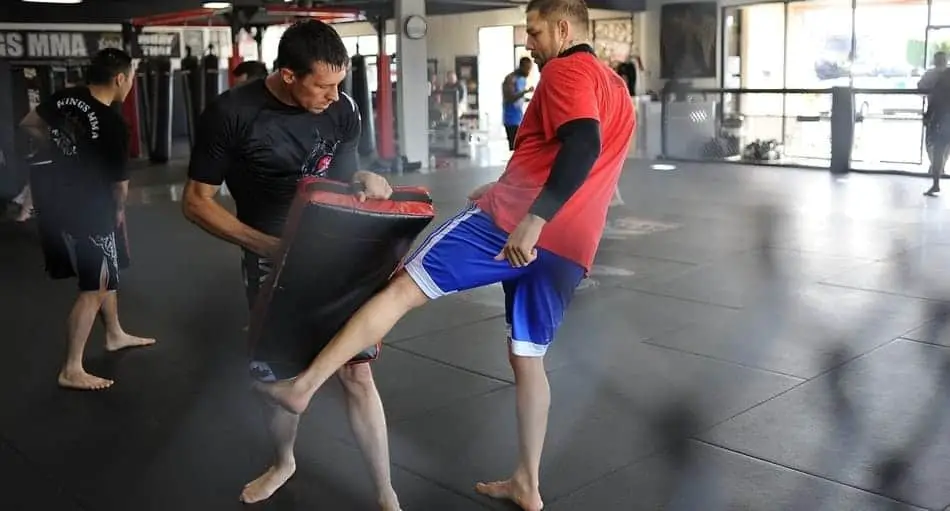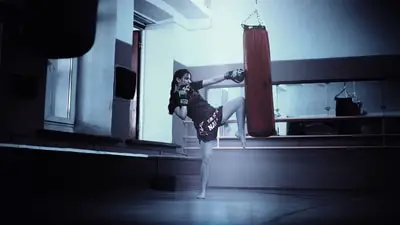
Kickboxing is one of the best combat sports out there. It’s quickly increasing its popularity among regular people recently after cardio kickboxing classes became a thing. But how hard exactly is kickboxing? This is the question I’m going to try to answer in detail in this article.
Is kickboxing hard? Kickboxing is a very technical sport and it’ll take you some time and effort before starting executing the technique correctly. Kickboxing workouts are fast-paced and endurance-focused. If you’re out of a shape before starting kickboxing, the first few classes will be really hard and exhausting. But after 1-2 weeks of training, your body will get used to the exercises and you won’t be so tired and have muscle soreness.
That actually applies to every sport – you are going to have muscle soreness in the first few weeks. But what about after that? Is kickboxing easier?
Well, it will be much easier for you compared to the beginning but still, kickboxing is not an easy sport. It’s a whole-body exercise and requires good cardio. That’s why kickboxing is so good for losing weight, improving your endurance and building lean muscle.
If I need to compare the most popular combat sports, I’ll put kickboxing right after wrestling (where wrestling is the hardest one) and before boxing and BJJ.
But when it comes to combat sports, the word “hard” has two different meanings. The first one is how grueling the workouts are and the other how many different techniques you need to master. In the rest of the article, I’ll try to answer those two questions in detail.
Is kickboxing hard for beginners?
Now, when comparing how hard given combat sports are, I’m usually looking at a competition perspective. But for beginners, it can be completely different.
For example, cardio kickboxing classes (fast-paced cardio workout combined with kickboxing techniques) are very different from standard kickboxing classes. Their goal is to help people lose weight or get into better shape while doing funnier activities than a regular fitness gym workout.
There isn’t full contact sparring and the focus is more on endurance rather than technique. In standard kickboxing classes technique is like 70-80% of the workout (drills; sparring) and 20-30% conditioning (rope jumping, push-ups; running, etc). In cardio-kickboxing classes, that ratio is roughly 50/50 or even 60% conditioning since conditioning is the main focus of the workouts.
So in some sense cardio kickboxing workouts can be harder when you are just starting in terms of endurance, cardio, etc.
But standard kickboxing classes require learning tons of technique which can be really hard to do especially if you don’t have any background in other striking martial arts.
Your punches will feel weird, your kicks will feel weak and slow and most likely at first, you won’t have the flexibility to throw high kicks and even when you kick, your shin will hurt. But that’s completely normal.
You’ll need hours of shadowboxing, and heavy bag work before starting to punch and kick correctly.
Sparring is also another hard part of your kickboxing workout.
Sparring
Full-contact sparring can be tough. Especially if you are doing it wrong. If it’s done correctly, it can be the funniest part of your kickboxing workout. And if it’s done wrong it can be the hardest one.
In standard (not cardio) kickboxing classes there is full-contact sparring at least 10 rounds a week. The problem is that most beginners are trying too hard, throwing with 100% power all the time and just beating each other up.
Which is a very unproductive and unhealthy way of sparring. Sparring needs to be more playful and even it almost slow-motion when you are a beginner. Sparring should be about learning timing, precision, distance management and how exactly to use effectively the techniques you’ve drilled.
But many (in fact almost all) beginners think it’s some sort of a fight and spar hard every time. Now, don’t get me wrong, I think there’s a place for hard sparring.
You should do hard sparring at some point so you can see that you aren’t made of glass and you can take a big hit. That’s really important because it’ll help you to stay composed after taking a hard punch/kick in a self-defense situation or even in competition.
I remember my first hard sparring ever. It was 3 months after I started boxing. I sparred hard with the guy that terrified me the most in the gym. Before I was just running across the ring trying to survive the rounds but this time I decided to stand my ground and throw punches back at him.
We did like 7 rounds and after that, I took (and delivered actually) some serious blows. I was so exhausted and a little dizzy but also felt indestructible. That helped me be less afraid at the same time more confident in myself.
The thing is that you should do hard sparring occasionally, not every week as most people do it. In my opinion, you should listen to your body and when you are sick of light sparring and want something a little more serious, maybe it’s time for hard sparring.
There are two big problems with hard sparring. The first one is the concussions. Brain trauma is a real threat to your health. Your brain can take only so many hard blows before starting developing CTE. The stupidest thing to do is to take hard punches/kicks to the head every week.
The second problem is just the fact that it sucks being beaten up every week. I saw many beginners sparring super hard every time and the quitting kickboxing/boxing after 1-2 months. Your workout should be fun, not damaging.
How difficult is kickboxing on the higher levels?
Kickboxing is a very hard sport when it comes to competition. One of the reasons for that is that there are many different kickboxing styles you need to prepare for. For example, there are people with Muay Thai background who are very good at the center of the ring when trading kicks.
There are people having dutch kickboxing style who have sick combinations with punches and kicks and good footwork. And there are people with a traditional martial arts background (taekwondo; karate). Which are very elusive and have dangerous spinning attacks (spinning back kicks, wheel kicks, etc) who can be really nasty in case you never fought/sparred with such fighters.
In order to be prepared for all those styles, you need to spar with different training partners, have very good conditioning. Kickboxing bouts are usually 3-5 rounds 3 minutes each which requires great endurance and pacing.
What should I expect from my first kickboxing class?
In some gyms, the first class won’t be that hard. The trainer will pull you aside together with the other first-timers and show you the basics – proper stance and basic footwork; how to throw jab and cross and maybe even some leg and body kicks.
And that will be the whole workout – he’ll let you just drill the things he/she showed you. These are only technique drills so you probably won’t feel exhausted at all after the workout is over.
In other gyms that may be a little different. The trainer will still show you the basics first but then he’ll let you do the same drills/exercises the rest of the group is doing. If he says to do push-ups; running; 5 min rope jumping etc, you need to do it too. And that can be quite hard.
So, my final words are yes, kickboxing is a hard sport because of the endurance you need to develop and the variety of different techniques you need to learn and execute correctly.



